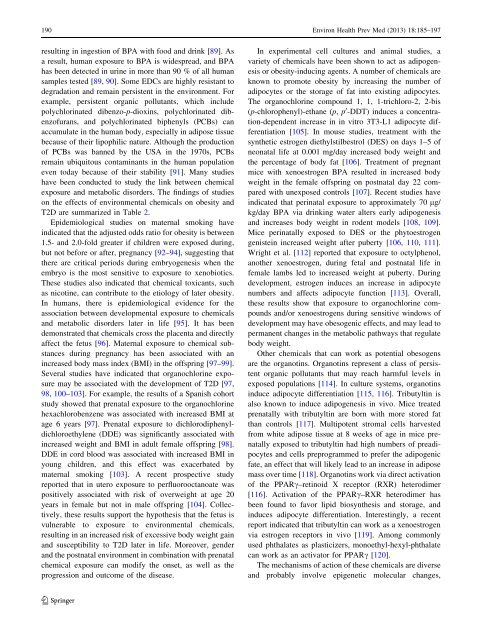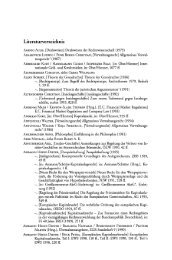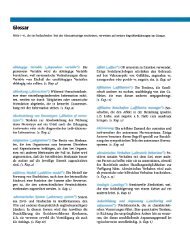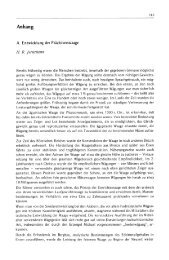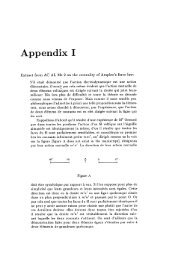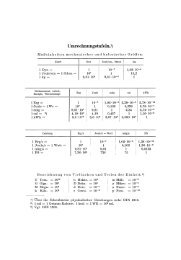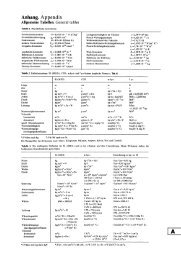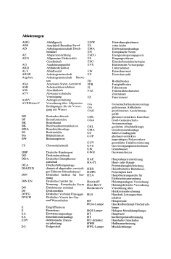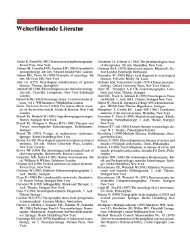Download PDF - Springer
Download PDF - Springer
Download PDF - Springer
Create successful ePaper yourself
Turn your PDF publications into a flip-book with our unique Google optimized e-Paper software.
190 Environ Health Prev Med (2013) 18:185–197resulting in ingestion of BPA with food and drink [89]. Asa result, human exposure to BPA is widespread, and BPAhas been detected in urine in more than 90 % of all humansamples tested [89, 90]. Some EDCs are highly resistant todegradation and remain persistent in the environment. Forexample, persistent organic pollutants, which includepolychlorinated dibenzo-p-dioxins, polychlorinated dibenzofurans,and polychlorinated biphenyls (PCBs) canaccumulate in the human body, especially in adipose tissuebecause of their lipophilic nature. Although the productionof PCBs was banned by the USA in the 1970s, PCBsremain ubiquitous contaminants in the human populationeven today because of their stability [91]. Many studieshave been conducted to study the link between chemicalexposure and metabolic disorders. The findings of studieson the effects of environmental chemicals on obesity andT2D are summarized in Table 2.Epidemiological studies on maternal smoking haveindicated that the adjusted odds ratio for obesity is between1.5- and 2.0-fold greater if children were exposed during,but not before or after, pregnancy [92–94], suggesting thatthere are critical periods during embryogenesis when theembryo is the most sensitive to exposure to xenobiotics.These studies also indicated that chemical toxicants, suchas nicotine, can contribute to the etiology of later obesity.In humans, there is epidemiological evidence for theassociation between developmental exposure to chemicalsand metabolic disorders later in life [95]. It has beendemonstrated that chemicals cross the placenta and directlyaffect the fetus [96]. Maternal exposure to chemical substancesduring pregnancy has been associated with anincreased body mass index (BMI) in the offspring [97–99].Several studies have indicated that organochlorine exposuremay be associated with the development of T2D [97,98, 100–103]. For example, the results of a Spanish cohortstudy showed that prenatal exposure to the organochlorinehexachlorobenzene was associated with increased BMI atage 6 years [97]. Prenatal exposure to dichlorodiphenyldichloroethylene(DDE) was significantly associated withincreased weight and BMI in adult female offspring [98].DDE in cord blood was associated with increased BMI inyoung children, and this effect was exacerbated bymaternal smoking [103]. A recent prospective studyreported that in utero exposure to perfluorooctanoate waspositively associated with risk of overweight at age 20years in female but not in male offspring [104]. Collectively,these results support the hypothesis that the fetus isvulnerable to exposure to environmental chemicals,resulting in an increased risk of excessive body weight gainand susceptibility to T2D later in life. Moreover, genderand the postnatal environment in combination with prenatalchemical exposure can modify the onset, as well as theprogression and outcome of the disease.In experimental cell cultures and animal studies, avariety of chemicals have been shown to act as adipogenesisor obesity-inducing agents. A number of chemicals areknown to promote obesity by increasing the number ofadipocytes or the storage of fat into existing adipocytes.The organochlorine compound 1, 1, 1-trichloro-2, 2-bis(p-chlorophenyl)-ethane (p, p 0 -DDT) induces a concentration-dependentincrease in in vitro 3T3-L1 adipocyte differentiation[105]. In mouse studies, treatment with thesynthetic estrogen diethylstilbestrol (DES) on days 1–5 ofneonatal life at 0.001 mg/day increased body weight andthe percentage of body fat [106]. Treatment of pregnantmice with xenoestrogen BPA resulted in increased bodyweight in the female offspring on postnatal day 22 comparedwith unexposed controls [107]. Recent studies haveindicated that perinatal exposure to approximately 70 lg/kg/day BPA via drinking water alters early adipogenesisand increases body weight in rodent models [108, 109].Mice perinatally exposed to DES or the phytoestrogengenistein increased weight after puberty [106, 110, 111].Wright et al. [112] reported that exposure to octylphenol,another xenoestrogen, during fetal and postnatal life infemale lambs led to increased weight at puberty. Duringdevelopment, estrogen induces an increase in adipocytenumbers and affects adipocyte function [113]. Overall,these results show that exposure to organochlorine compoundsand/or xenoestrogens during sensitive windows ofdevelopment may have obesogenic effects, and may lead topermanent changes in the metabolic pathways that regulatebody weight.Other chemicals that can work as potential obesogensare the organotins. Organotins represent a class of persistentorganic pollutants that may reach harmful levels inexposed populations [114]. In culture systems, organotinsinduce adipocyte differentiation [115, 116]. Tributyltin isalso known to induce adipogenesis in vivo. Mice treatedprenatally with tributyltin are born with more stored fatthan controls [117]. Multipotent stromal cells harvestedfrom white adipose tissue at 8 weeks of age in mice prenatallyexposed to tributyltin had high numbers of preadipocytesand cells preprogrammed to prefer the adipogenicfate, an effect that will likely lead to an increase in adiposemass over time [118]. Organotins work via direct activationof the PPARc–retinoid X receptor (RXR) heterodimer[116]. Activation of the PPARc–RXR heterodimer hasbeen found to favor lipid biosynthesis and storage, andinduces adipocyte differentiation. Interestingly, a recentreport indicated that tributyltin can work as a xenoestrogenvia estrogen receptors in vivo [119]. Among commonlyused phthalates as plasticizers, monoethyl-hexyl-phthalatecan work as an activator for PPARc [120].The mechanisms of action of these chemicals are diverseand probably involve epigenetic molecular changes,123


